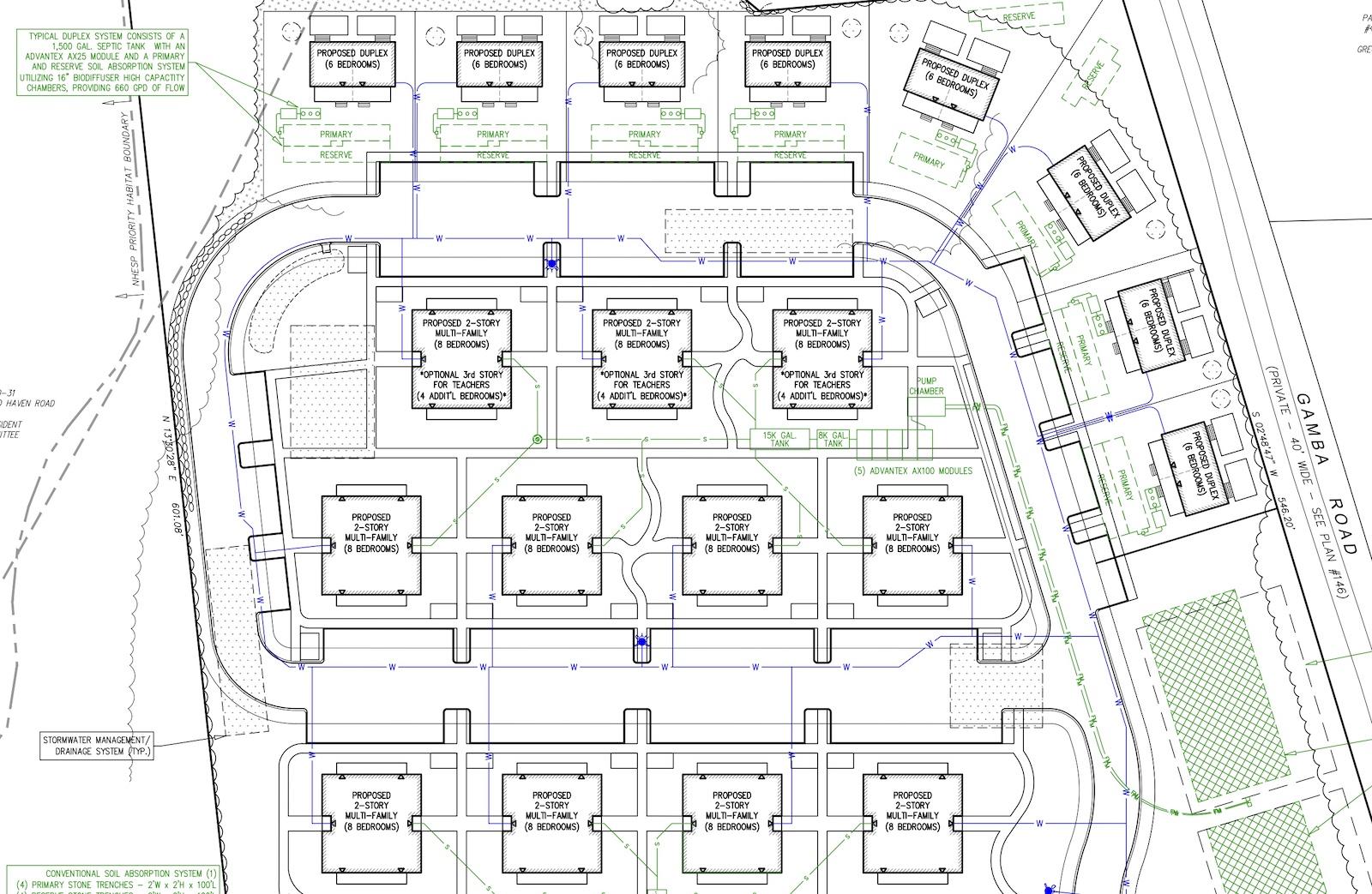Oak Bluffs Wrestles with Wastewater for Green Villa Housing Project – The Vineyard Gazette

Report on the Green Villa Housing Proposal and Sustainable Development Goal Implications
Executive Summary: Alignment with SDG 11 (Sustainable Cities and Communities)
The proposed 116-unit Green Villa housing project in Oak Bluffs represents a significant effort to address the United Nations Sustainable Development Goal 11, which aims to make cities and human settlements inclusive, safe, resilient, and sustainable. The project directly targets SDG 11.1 by seeking to provide access to adequate, safe, and affordable housing. However, its implementation is challenged by critical infrastructure limitations, particularly concerning wastewater management, which directly impacts other key SDGs.
- Project Scope: 116 residential units.
- Affordability Focus: The development includes provisions for affordable housing, units for residents earning 150% of the area median income, and dedicated housing for teachers, contributing to SDG 10 (Reduced Inequalities).
- Primary Obstacle: Insufficient municipal wastewater capacity, creating a conflict between housing development goals (SDG 11) and environmental sustainability goals (SDG 6 and SDG 14).
Wastewater Infrastructure and Challenges to SDG 6 (Clean Water and Sanitation)
The central conflict surrounding the Green Villa project is its demand on the town’s wastewater system, highlighting a critical challenge in achieving SDG 6 (Clean Water and Sanitation for All). The town’s capacity to manage wastewater sustainably is at the core of the debate, with existing commitments severely limiting availability for new, large-scale developments.
Analysis of Wastewater Capacity
- Projected Demand: The Green Villa project requires between 7,400 and 15,000 gallons of wastewater capacity per day.
- Future Municipal Capacity: Oak Bluffs anticipates an additional 150,000 gallons of capacity by 2028.
- Pre-existing Allocations:
- 130,000 gallons: Reserved for nitrogen reduction initiatives. This commitment is crucial for meeting SDG 6.3 (improving water quality) and SDG 14 (Life Below Water) by protecting marine ecosystems from pollution.
- 12,000 gallons: Committed to other community projects, including the Tackenash Knoll housing development, veteran housing, and the Martha’s Vineyard YMCA.
These allocations leave insufficient capacity for the Green Villa project, forcing a re-evaluation of how to balance the urgent need for housing with the long-term environmental health and sustainability of the town’s water resources.
Proposed Solutions and Partnership Models (SDG 17)
In response to the infrastructure deficit, the developer has presented three potential paths forward to the town’s zoning board of appeals. These proposals reflect different approaches to public-private partnerships, a key component of SDG 17 (Partnerships for the Goals).
- Full Municipal Connection: The town would provide the necessary sewer flow for all 116 units, placing the full infrastructure burden on the municipality.
- Hybrid System: The project would utilize a combination of municipal sewer connections and onsite septic systems. To offset the estimated $1.5 million cost of septic installation, the developer would add two duplexes to the project.
- Financial Contribution Partnership: The town would provide sewer hookups for all 116 units plus two additional duplexes. In return, the developer would contribute $1.5 million to the town for use in affordable housing or infrastructure betterment initiatives, creating a direct financial partnership to advance shared community goals.
Governance and Integrated Planning
The project is currently undergoing concurrent reviews by the Oak Bluffs zoning board of appeals and the Martha’s Vineyard Commission (MVC), a process complicated by ongoing legal disputes. This situation underscores the challenges in achieving SDG 11.3, which calls for inclusive and sustainable urbanization and integrated settlement planning.
- A dedicated wastewater working group has been formed to facilitate dialogue between the developer and town officials, aiming to find a sustainable solution.
- The zoning board is seeking a definitive answer on capacity from the wastewater commission to move forward, emphasizing the need for strong and decisive institutions (SDG 16).
- Complexities in implementing and enforcing income- and occupation-based housing restrictions for teachers and middle-income residents highlight the administrative challenges in ensuring that development projects achieve their intended social equity outcomes under SDG 10.
Analysis of Sustainable Development Goals in the Article
1. Which SDGs are addressed or connected to the issues highlighted in the article?
-
SDG 6: Clean Water and Sanitation
The article’s central conflict revolves around the town’s wastewater treatment capacity. The discussion about providing sewer hookups, managing wastewater flow (7,400 to 15,000 gallons a day), and the allocation of future capacity for “nitrogen reduction” directly relates to the management of water and sanitation services.
-
SDG 9: Industry, Innovation and Infrastructure
The debate over whether the town’s sewer system can support the new 116-unit housing project is fundamentally an issue of infrastructure. The developer’s proposal to contribute $1.5 million for “infrastructure betterment” further underscores the connection to developing and financing sustainable and resilient infrastructure to support new development.
-
SDG 11: Sustainable Cities and Communities
The article focuses on a large housing proposal designed to address the local housing market crisis. It explicitly mentions the provision of “affordable housing” and units for middle-income earners and teachers, which directly aligns with the goal of making cities and human settlements inclusive, safe, resilient, and sustainable by ensuring access to adequate and affordable housing.
-
SDG 17: Partnerships for the Goals
The process described involves multiple stakeholders working together, including a private developer (Green Villa), various public town bodies (zoning board of appeals, wastewater commission), and a regional authority (Martha’s Vineyard Commission). The creation of a “wastewater working group” to address the capacity issue is a clear example of a public-private partnership aimed at achieving a development goal.
2. What specific targets under those SDGs can be identified based on the article’s content?
-
Target 6.3: Improve water quality by reducing pollution and treating wastewater
This target is relevant because the town has already allocated 130,000 gallons of its future wastewater capacity specifically for “nitrogen reduction.” This indicates an effort to improve water quality by treating wastewater to remove pollutants like nitrogen before discharge, which is a core component of this target.
-
Target 9.1: Develop quality, reliable, sustainable and resilient infrastructure
The entire discussion about whether the town’s sewer system has sufficient capacity for the new development falls under this target. The town is assessing the reliability and capacity of its existing sanitation infrastructure to support community growth. The developer’s offer to fund “infrastructure betterment” is a direct attempt to contribute to this goal.
-
Target 11.1: Ensure access for all to adequate, safe and affordable housing
The Green Villa project, a 116-unit development, is a direct response to the rising cost of the local housing market. The plan to include “affordable housing” and set aside units for specific income levels (150% of the Island’s average median income) and occupations (teachers) directly addresses the need for adequate and affordable housing for all segments of the community.
-
Target 17.17: Encourage and promote effective public, public-private and civil society partnerships
The article highlights the formation of a “wastewater working group” where town officials and the private developer meet to solve the capacity issue. This collaboration, along with the concurrent reviews by the zoning board and the Martha’s Vineyard Commission, exemplifies the multi-stakeholder partnerships needed for sustainable development projects.
3. Are there any indicators mentioned or implied in the article that can be used to measure progress towards the identified targets?
-
Indicator for Target 6.3 (Implied): Volume of wastewater treated
The article provides specific quantitative data that can be used to measure wastewater management. This includes the project’s required flow (7,400 to 15,000 gallons a day), the town’s expected additional capacity (150,000 gallons by 2028), and the allocation of that capacity to other projects (12,000 gallons for Tackenash Knoll, etc.). These figures are direct measures of wastewater volume being considered for treatment.
-
Indicator for Target 9.1 (Implied): Investment in infrastructure
A specific financial figure is mentioned as a potential investment in local infrastructure. The developer’s proposal to give the town “$1.5 million to be used in any affordable/infrastructure betterment initiative” serves as a direct monetary indicator of investment towards improving infrastructure.
-
Indicator for Target 11.1 (Implied): Number of new affordable housing units
The article specifies the scale of the project as a “116-unit Green Villa housing project.” It also notes that sections will be set aside for affordable housing, middle-income buyers, and teachers. The number of units created for these specific groups would be a direct indicator of progress toward providing affordable housing.
-
Indicator for Target 17.17 (Qualitative): Existence of multi-stakeholder partnerships
The article provides qualitative evidence of partnerships. The establishment of the “wastewater working group” involving town officials and the developer is a concrete example. The ongoing negotiations and concurrent reviews by different public bodies (zoning board, wastewater commission, MVC) also serve as an indicator of a functioning, albeit complex, multi-stakeholder governance structure for the project.
4. Table of SDGs, Targets, and Indicators
| SDGs | Targets | Indicators Identified in the Article |
|---|---|---|
| SDG 6: Clean Water and Sanitation | Target 6.3: Improve water quality by reducing pollution and treating wastewater. | The volume of wastewater requiring treatment (7,400-15,000 gallons/day) and the allocation of future capacity (130,000 gallons) for nitrogen reduction. |
| SDG 9: Industry, Innovation and Infrastructure | Target 9.1: Develop quality, reliable, sustainable and resilient infrastructure. | The proposed investment of $1.5 million for “infrastructure betterment” and the assessment of the town’s sewer system capacity. |
| SDG 11: Sustainable Cities and Communities | Target 11.1: Ensure access for all to adequate, safe and affordable housing. | The creation of 116 new housing units, with specific sections for affordable housing, middle-income earners (150% AMI), and teachers. |
| SDG 17: Partnerships for the Goals | Target 17.17: Encourage and promote effective public, public-private and civil society partnerships. | The formation of a “wastewater working group” with the developer and town officials, and the multi-agency review process involving the zoning board and MVC. |
Source: vineyardgazette.com
What is Your Reaction?
 Like
0
Like
0
 Dislike
0
Dislike
0
 Love
0
Love
0
 Funny
0
Funny
0
 Angry
0
Angry
0
 Sad
0
Sad
0
 Wow
0
Wow
0















































/environment-climate-change-and-health-(ech)/water-sanitation-hygiene-and-health-(wsh)/landfill-tuvalu-36092.tmb-1200v.jpg?sfvrsn=5c21fe40_1#)


.jpg.webp?itok=0ZsAnae9#)

























